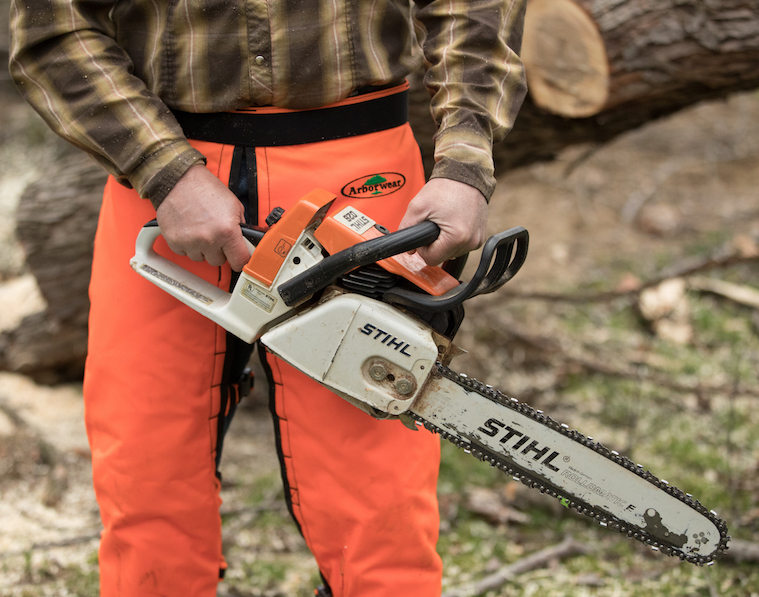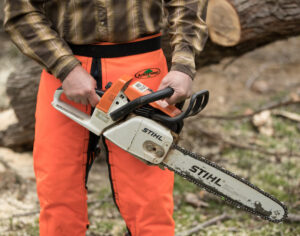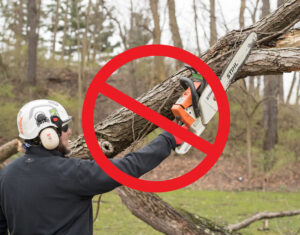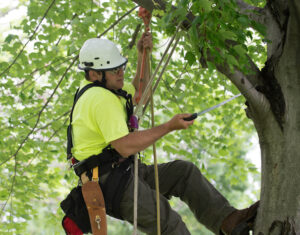ANSI Updates Crack Down on Chain Saw Safety

By Matthew Knull
People have different preferences. Different ways they like to work, accomplish tasks, and all sorts of other things. This is extremely evident in tasks and methods for the business of arboriculture and the tree care industry in general.
Although many of these methods are safe and acceptable, some are not. The one-handed use of top-handled chain saws is currently a subject of debate by practitioners in the arboriculture industry. The design of the top-handled chain saw makes it possible, and extremely tempting, to operate with only one hand to control the saw and throttle simultaneously. Some practitioners believe that there are certain situations where one-handing these saws in a tree is acceptable and the safest method to make a cut. From my experience working in trees, I have not found myself in a situation where an extra minute of work positioning, or the addition of a tagline, couldn’t allow me to more safely and comfortably make a cut using both hands to control the chain saw.
One-handing a chain saw is never a safe alternative to using two hands. Without both hands, the operator has little control of the saw, making them far more vulnerable to rotational kickback and cutting themselves. Rotational kickback occurs when the upper quadrant of the chain saw bar tip comes into contact with wood or other matter, causing the top of the chain saw bar to jolt suddenly toward the operator at very high speeds. The second hand on the saw keeps it from jolting back and can also activate the chain brake, instantly stopping the chain from spinning.
Taking the extra time to set a tagline at the top of a piece of wood from a spar and/or using climbing lines and lanyards to gain a better, more comfortable work position, is always a safer alternative to one-handing a chain saw. And, after you take that extra time to do so, you become a better climber, making it even easier to properly position yourself each and every time.

The most recent version of the ANSI Z133 safety standards for arboriculture was released in 2017. This new version contains some new regulations pertaining to the use of chain saws in a tree, and the importance of keeping both hands on the saw when cutting. These changes are the following:
Changes to chain saw use regulations
Proper hand placement in the ANSI Z133 is defined under section 6.3.5. The language specifically states:
A chain saw shall be operated with two hands at all times, one hand on each handle with thumbs wrapped around the handles.
The operatorshalloperate the chain saw with the left hand and thumb gripped firmly around the forward handle and the right handand thumb gripped firmly around the rear handle, unless it is not practicable, and theemployer demonstrates that a greater hazard is posed by operating the chain saw that way in that particular situation.
This passage, taken from the 2017 revision of the ANSI Z133 contains a small, however, important change.
In this standard, the word “shall” designates a mandatory regulation. Using the word “should” designates an advised regulation. It is important to note that this paragraph in the standard uses the word “shall” when addressing using two hands on a chain saw, making the use of two hands on the chain saw while cutting a mandatory regulation.
The new version is still specific as to where the hands need to be placed while operating a chain saw. This specificity makes it mandatory for a chain saw to be operated right-handed. They do not make left-handed chain saws, and according to section 6.3.5, one is not permitted to operate a chain saw with the left hand on the throttle.

However, the tail of section 6.3.5 permits the employer to sanction his or her employees to use a chain saw in an ambidextrous fashion. This may be because many people believe that in certain situations it may be safer to operate the throttle left-handed – possibly while making a back cut on a leaning tree, or when cutting a stump lower.
The Occupational Safety and Health Administration (OSHA) requires all employers ensure their working environment is “free from recognizable hazards that are likely to cause death or serious harm to employees,” per the organization’s General Duty clause. Therefore, in order to maintain this requirement, it is important for employers to stay updated and enforce all changes to the ANSI Z133.
Practical application
In the field, there is always the temptation to take shortcuts and get things done quickly to please the employer, making one-handing saws an appealing method to make tricky cuts. It is important, for the safety of your employees, to provide education, training, and consistent coaching for all employees put in situations where they may be making these cuts. Exercises in work positioning, and the use of hand saws, pole saws and taglines, will help employees find alternatives to using a chain saw one handed.

The beautiful thing about the hand saw is that we are able to use it with one hand. This allows the utilization of our free hand for stabilization and balance while making the cut.
However, taking the time to learn good work positioning is probably the most sustainable and ergonomically efficient way to make cuts if you plan on working on trees for many years. The importance of skills built while learning to get your body in the perfect working position for every cut far exceeds the extra time spent doing so.
Using a chain saw improperly is a lot like rolling dice. You can get lucky again and again, but eventually you will lose. Following the rules presented in the ANSI Z133 is like wearing a seatbelt in your car. You might be able to get away without using it time and time again, but when the day comes that you need it, you will be glad you followed the rules – whether it was wearing your seat belt when you get hit by another vehicle or you experience violent kickback while trying to make a cut in a vine-covered tree.
Matthew Knull is an ISA-certified arborist, Certified Treecare Safety Professional, certified by (TCIA), and an Arborist Training Instructor with ACRT. He holds a Bachelor of Science degree in forestry and natural resources from the University of Georgia.
Photos provided by ACRT.
For more information, visit ACRT.com


